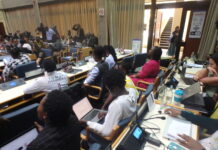By Mary Mwendwa
Deep in the heart of the famous Maasai Mara National Reserve in Kenya, a solar energy revolution is changing lives as women and children benefit more.The park is famous for the wild beast migration wonder and spectacular views of wildlife and other sites that attract tourists.
At Talek village in the Maasai Mara, a group of women who have come together to save money and get empowered have invested in solar lamps, cookers and other solar gadgets that has seen their lives change in big way.
These women through a project by Basecamp Foundation which targets to empower women in the Mara has seen women form groups save money and buy household items like solar lamps, light and many more.

According to Noomeshuki Ketikai a mother of two from Talek village, at 18 she had never stepped in a school but owes alot of gratitude to the Community Managed MicroFinance (CMMF) .”Iam happy that I can now use solar energy for my lighting and at times cooking, I had never stepped in a classroom and my life has been full of misery because even counting money was a problem .But through my group which trains me on many things including using solar lamps, charging systems and cooking iam now an empowered woman.Solar energy has come as a savoir in this village.”She says.
Similarly, Taiyana Lenjirr, a 22 year old mother says that her life has changes alot after she started using solar energy in her house.”I have young children and before solar lighting came in my house my children used to get chest infections because of the carbon from the small paraffin lamp.It was very difficult to attend to them while breastfeeding mostly at night.But now with the solar lamp iam happy, i cook nicely and take time to feed my children without worrying of paraffin to be finished.”

Debra Kaigil, CMMF Officer, Basecamp Foundation testifies to how solar energy revolution has changed women lives in the Mara.”I work with over 2000 women here in the villages of Mara.Many of them when we met had nothing and were living in poverty and desperation.But when we started training then on savings and loans they got knowledge and many have bought solar lights, cookers and chargers for their phones.We have witnessed improvement among school going children who use the solar lamps to study and the women are on network throughout the day.There are no instances of phones off because of lack of power.As you know villages here are very far from each other and without phone communication it can be very hard to reach the women in the groups.”Debra says.
Kenya is characterized by an electrification rate of 15-20 % only and a growth of electricity demand of 5-8% per annum, in a country that has a GDP growth rate of 4,3 %.
In Sub-Saharan Africa, over 80 % of the primary energy consumption remains for domestic use only, mostly in traditional biomass. At the same time, access to electricity is a requirement for many productive and social uses. It is widely argued that increasing the access figures will require not only public investment, but also a substantial uptake of private sector activity.

Michael Franz, project manager at the EU Energy Initiative Partnership Dialogue Facility views solar energy penetration in Africa ;”Dramatic cost reductions in solar photovoltaic devices are making it increasingly economically viable to improve access to solar energy in Africa but opportunities are lost because policy and regulatory frameworks, and development instruments, are not yet adapted.”
Drawing his conclusions from several years of working in the Kenyan energy sector, he points out that a number of the conditions and lessons learnt are similar to those of other countries in Sub-Saharan Africa.














